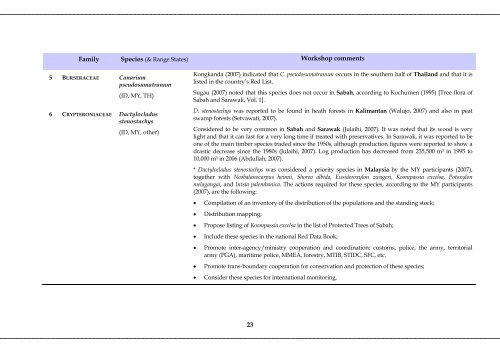strategies for the sustainable use and management of timber tree ...
strategies for the sustainable use and management of timber tree ...
strategies for the sustainable use and management of timber tree ...
You also want an ePaper? Increase the reach of your titles
YUMPU automatically turns print PDFs into web optimized ePapers that Google loves.
Family Species (& Range States) Workshop comments<br />
5 BURSERACEAE Canarium<br />
pseudosumatranum<br />
(ID, MY, TH)<br />
6 CRYPTERONIACEAE Dactylocladus<br />
stenostachys<br />
(ID, MY, o<strong>the</strong>r)<br />
Kongk<strong>and</strong>a (2007) indicated that C. pseudosumatranum occurs in <strong>the</strong> sou<strong>the</strong>rn half <strong>of</strong> Thail<strong>and</strong> <strong>and</strong> that it is<br />
listed in <strong>the</strong> country’s Red List.<br />
Sugau (2007) noted that this species does not occur in Sabah, according to Kochumen (1995) [Tree flora <strong>of</strong><br />
Sabah <strong>and</strong> Sarawak, Vol. 1].<br />
D. stenostachys was reported to be found in heath <strong>for</strong>ests in Kalimantan (Walujo, 2007) <strong>and</strong> also in peat<br />
swamp <strong>for</strong>ests (Setvawati, 2007).<br />
Considered to be very common in Sabah <strong>and</strong> Sarawak (Julaihi, 2007). It was noted that its wood is very<br />
light <strong>and</strong> that it can last <strong>for</strong> a very long time if treated with preservatives. In Sarawak, it was reported to be<br />
one <strong>of</strong> <strong>the</strong> main <strong>timber</strong> species traded since <strong>the</strong> 1950s, although production figures were reported to show a<br />
drastic decrease since <strong>the</strong> 1980s (Julaihi, 2007). Log production has decreased from 235,500 m 3 in 1995 to<br />
10,000 m 3 in 2006 (Abdullah, 2007).<br />
* Dactylocladus stenostachys was considered a priority species in Malaysia by <strong>the</strong> MY participants (2007),<br />
toge<strong>the</strong>r with Neobalanocarpus heimii, Shorea albida, Eusideroxylon zwageri, Koompassia excelsa, Potoxylon<br />
melagangai, <strong>and</strong> Intsia palembanica. The actions required <strong>for</strong> <strong>the</strong>se species, according to <strong>the</strong> MY participants<br />
(2007), are <strong>the</strong> following:<br />
• Compilation <strong>of</strong> an inventory <strong>of</strong> <strong>the</strong> distribution <strong>of</strong> <strong>the</strong> populations <strong>and</strong> <strong>the</strong> st<strong>and</strong>ing stock;<br />
• Distribution mapping;<br />
• Propose listing <strong>of</strong> Koompassia excelsa in <strong>the</strong> list <strong>of</strong> Protected Trees <strong>of</strong> Sabah;<br />
• Include <strong>the</strong>se species in <strong>the</strong> national Red Data Book;<br />
• Promote inter-agency/ministry cooperation <strong>and</strong> coordination: customs, police, <strong>the</strong> army, territorial<br />
army (PGA), maritime police, MMEA, <strong>for</strong>estry, MTIB, STIDC, SFC, etc.<br />
• Promote trans-boundary cooperation <strong>for</strong> conservation <strong>and</strong> protection <strong>of</strong> <strong>the</strong>se species;<br />
• Consider <strong>the</strong>se species <strong>for</strong> international monitoring.<br />
23

















